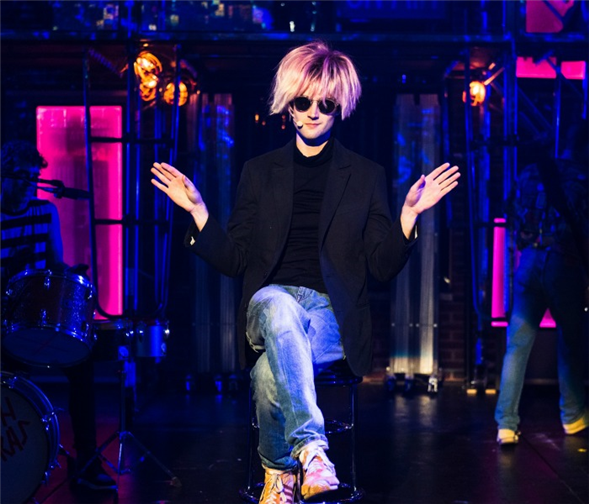Translate Page

How set designer Jason Sherwood put Studio 54, The Mudd Club and Andy Warhol's Factory all on one stage
---
How do you conjure three legendary hot spots from New York's past in an intimate Off-Broadway venue? That's the formidable challenge 28-year-old scenic designer Jason Sherwood faced with This Ain't No Disco at Atlantic Theater Company. A world-premiere rock opera written by Stephen Trask (of Hedwig and the Angry Inch fame), Peter Yanowitz and Tony nominee Rick Elice (Jersey Boys), the show is set in 1979 when the city was gritty and countercultures were clashing. It chronicles the fortunes of two young aspiring artists from Queens as they get caught up in various scenes, including Studio 54, the Mudd Club and Andy Warhol's Factory.
In order to craft such disparate locales, Sherwood created a wraparound, three-level scaffolding to open up the space so visual signifiers for each setting could pop in and out. For Studio 54, it's the iconic logo and a pair of light towers. "Ian Schrager [the club's cofounder] has an incredible coffee-table book about 54," says Sherwood. "We spent time with that as I wanted to make sure that there was an aspect of history in this. When it comes to an item that feels totemic, it's those towers, designed by Jules Fisher, the famous lighting designer." Instead of having them descend from on high, Sherwood decided to have the towers lean in, in part due to lack of fly space but also because of the skewed perspective it inspires. "If you've ever been on a dance floor, your sense of vertigo and up and down is altered," he says. "So I started angling them, putting them at strange physical dimensions to the space."
{Image1}
The Mudd Club madness is depicted from the outside, as punks desperate to enter are held at bay by an S&M-style chain instead of 54's velvet rope. And a wall of silver tinfoil evokes Warhol's Factory -- the real space was covered with the stuff. "It evolved out of what was going to seem like the most fun to us," says Sherwood. "It had to be the one thing that came out of nowhere, that you didn't anticipate, and then when it went away, you were like, 'What? Did that really...?' I wanted to take people very distinctly to a place, even if they weren't familiar with those elements at all."
The atmosphere extends to the ceiling, where Aaron Rhyne's projections of posters and marquees from the era appear and often overlap. "This period of time is all about people building on each other -- a person develops an idea and another person sort of riffs on it, artistically," says Sherwood. "The word we kept coming back to was 'cacophony.' We wanted it to feel like a visual everywhere you looked, that overwhelming sense, and then have the ability to completely strip it down."
{Image2}
Sherwood is well-versed in "overwhelming" design. In 2017, he earned raves for his work on the Off-Broadway musical The View UpStairs that seated the audience inside a 1970s New Orleans gay bar. "That was weird for me at first, because I don't do places, like a real room, necessarily," he says. "The show was about a haven that was meant to protect you, so it had to be like a cocoon. It had to make you feel comfortable. One night, I watched when someone went over to the jukebox on set and tried to play a song. It was the best. I walked away being like, I should open a bar!"
Perhaps one day he will. After all, Sherwood, who studied at NYU and was mentored by Tony-winning set designer Derek McLane, has been expanding his résumé beyond the theatre with a variety of projects. This fall, he'll handle production design for the People's Choice Awards on E!, and he's been collaborating on singer Sam Smith's tour. "Sam wanted to work with someone who also loved disco music and who was also a young gay man, and we just immediately understood each other," Sherwood says. "It was the most fun ever, because they wanted something theatrical and they wanted something weird, but there were no parameters in the sense that you don't have to go to three different places. It just had to be something beautiful."
But the stage is definitely Sherwood's home. "The great privilege of being a theatre artist is that you're asked to bring your set of experiences, and perhaps put them entirely aside in favor of learning something new about a group of people or a place that you know nothing about," he says. "It's a huge honor to get to spend your life learning about other kinds of people."
To read about a student's experience at This Ain't No Disco, check out this post on TDF's sister site SEEN.
---
TDF MEMBERS: At press time, discount tickets were available for This Ain't No Disco. Go here to browse our current offers.
Follow Michael Martin at @martinized. Follow TDF at @TDFNYC.
Top image: Will Connolly in This Ain't No Disco. Photos by Ben Arons.